ISSN ONLINE(2319-8753)PRINT(2347-6710)
ISSN ONLINE(2319-8753)PRINT(2347-6710)
| Darshan A. Bhatt , Hardik R Mehta Assistant Professor, Department of Mechanical Engineering, Indus University, Ahmedabad, Gujarat, India1 |
| Related article at Pubmed, Scholar Google |
Visit for more related articles at International Journal of Innovative Research in Science, Engineering and Technology
Casting industries suffer from poor quality and productivity due to large no. of defects. Investment Casting is one such type of casting method which can cast the material .Among different types of casting processes, Investment Casting is most widely used as it has significant advantages as compare with other casting processes. Earlier we were getting too much rejection on crankcase because of Shrinkage and porosity. This Research paper is based on how to reduce the rejection rate by applying varying parameters on crankcase through Investment Casting. To achieve the best possible solution we have conducted series of experiments by applying varying parameters like pressure, temperature, holding time etc. on Injection Moulding machine.
Keywords |
| Investment Casting, Pouring & Melting, injection moulding, rejection rate |
INTRODUCTION |
| Investment Casting is a manufacturing process in which a wax pattern is coated with a refractory ceramic material. Once the ceramic material is hardened its internal geometry takes the shape of the casting. The wax is melted out and molten metal is poured into the cavity where the wax pattern was. The metal solidifies within the ceramic mold and then the metal casting is broken out. This manufacturing technique is also known as lost wax process. The first step in investment casting is to manufacture the wax pattern for the process. It can be made from paraffin since it will melt out easily and wax can be reused. When producing parts in any quantity, a mold from which to manufacture patterns will be desired. Similar to the mold that may be employed in the expanded Investment casting process to produce patterns; the mold to create wax patterns may be cast or machined. The size of this master die must be carefully calculated. It must take into consideration shrinkage of wax, shrinkage of the ceramic material invested over the wax pattern and shrinkage of the metal casting |
II. MATERIALS AND METHOD |
| Crankcase will be made up with Mild Steel Material which has 7861.093kg/m3 density, Young’s Modulus is 2, 10,000 MPa., Melting temperature 1350-1530°C (2462-2786°F),Tensile strength is 45-54 kgf/mm2. Methods of manufacturing crankcase are Investment Casting. It involves Wax Preparation, Mold making, Slurry preparation, pouring and melting and surface finishing. |
III. EXPERIMENTAL SETUP |
| a) In this study, the effect of various parameters like holding time, temperature & pressure during molding on Injection Molding m/c we have investigated. Casting Process: Investment Casting Casting Parameters: Holding time, Pressure, temperature. |
| Machine: Injection molding machine. Material : Wax |
| b) Expandable patterns and gating system: an expandable pattern may be made of wax being more commonly used small shallow vents cut in the parting surface of the die provide adequate venting. Gates and sprue are formed in the same manner as the wax patterns attached to the pattern assembly. A pattern is produced for each casting to be made enable many small casting to be poured in one group for economy form a system of runners and feeders that allows metal to flow into each casting cavity. |
| c) Wax Pattern Making : Injection Molding machine should be cleaned switch on the injection press stirrer of the tank, heater block and nozzle. Keep the temperature as per the pattern size, intricacy, and number of cavity in the die. Then set injection pressure-flow as per the patterns size, intricacy and number of cavity in the die. If pieces found rejected set the parameters can be adjusted, if pieces found ok run the press automatically. |
| d) Since the mold does not need to be opened, castings of very complex geometry can be manufactured. Several wax patterns may be combined for a single casting. Or as often the case, many wax patterns may be connected and poured together producing many castings in a single process. This is done by attaching the wax patterns to a wax bar, the bar serves as a central sprue. A ceramic pouring cup is attached to the end of the bar. This arrangement is called a tree, denoting the similarity of casting patterns on the central runner beam to branches on a tree. |
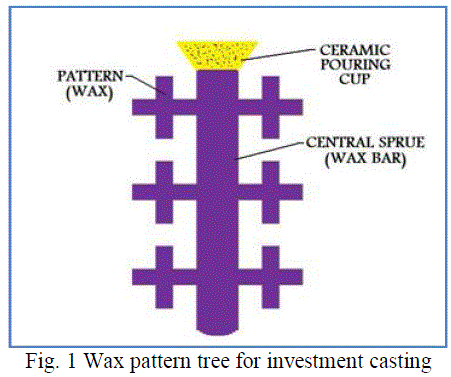 |
| In Fig. 1 describe the wax pattern tree. In which patterns are made of with wax and it attached to the wax bar before it goes to the slurry preparation it was arranged in that type of manner. The metal casting pattern is then dipped in refractory slurry whose composition includes extremely fine grained silica, water and binders. A ceramic layer is obtained over the surface of the pattern. The pattern is then repeatedly dipped into the slurry to increase the thickness of the ceramic coat. In some cases the pattern may be placed in a flask and the ceramic slurry poured over it. |
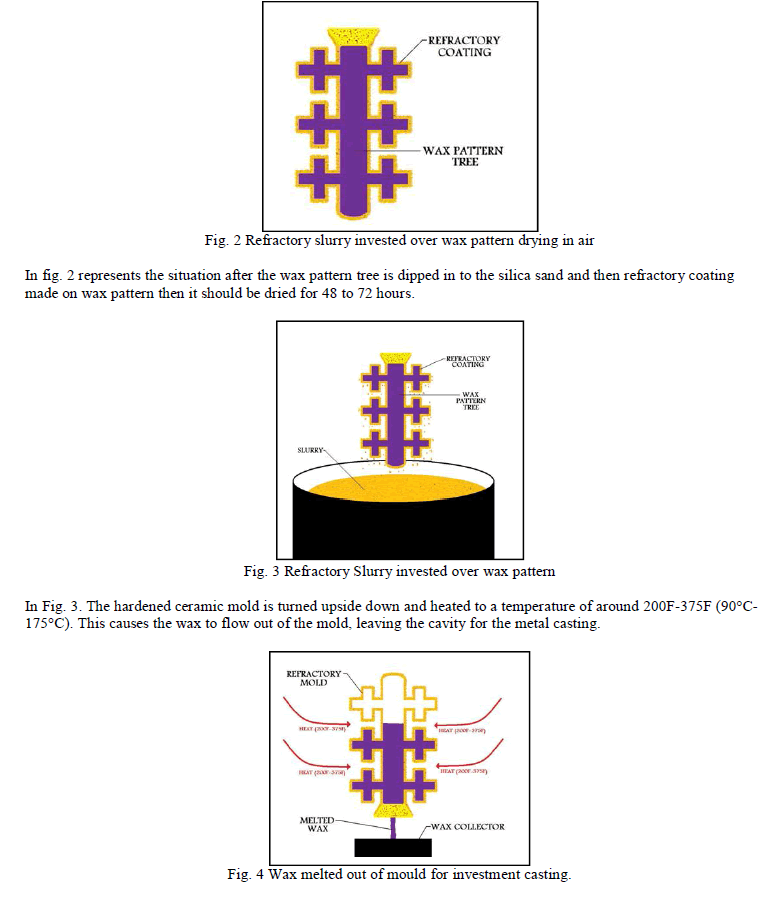 |
| In Fig. 4 the ceramic mold is then heated to around 1000°F-2000°F (550 °C-1100°C). This will further strengthen the mold, eliminate any leftover wax or contaminants and drive out water from the mold material. The metal casting is then poured while the mold is still hot. Pouring the casting while the mold is hot allows the liquid metal to flow easily through the mold cavity, filling detailed and thin sections. Pouring the metal casting in a hot mold also gives better dimensional accuracy, since the mold and casting will shrink together as they cool. |
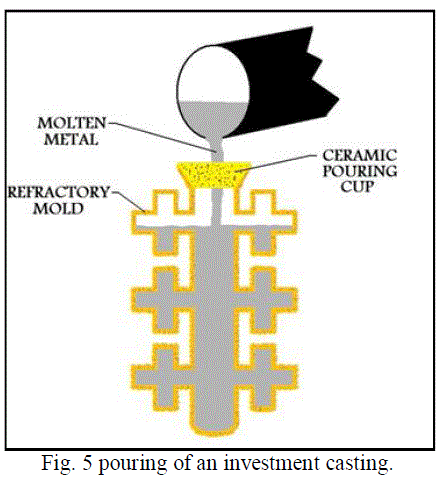 |
| In Fig. 5 Molten metal is pouring in to the mould and gradually it becomes harder. After pouring the molten metal mould should be put in quenching media like water oil or in sand then it goes for surface finishing process. |
IV. EXPERIMENTAL RESULTS |
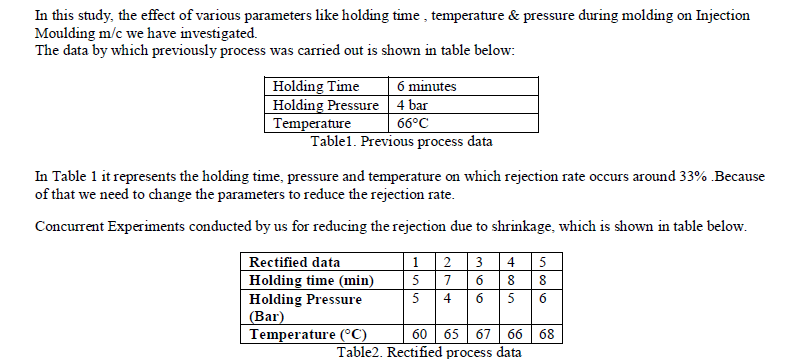 |
| In Table 2 represents the parameters which we had set up for reducing the rejection rate. With the above parameters mentioned in table 2 we were able to achieve rejection rate 10 % from 33% in Table 1. |
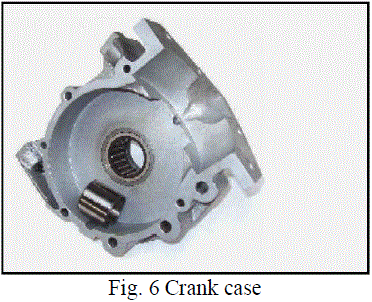 |
| In Fig. 6 mentioned the image of crank case with the rectified Process data. |
V. CONCLUSION |
| a) By doing an extensive experiments on crankcase it has been found that increasing the holding time 30 % ,increasing the pressure 50 % with the same temperature (earlier they were using) we could able to reduce the rejection rate by more than 60% than previous setup. The same result can be seen in table no.2 (test 5) b) Holding time 8 minutes, Holding Pressure 6 Bar and temperature 68°C is the optimum result. |
References |
|